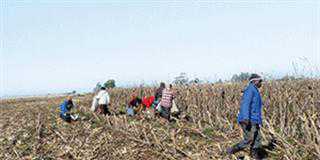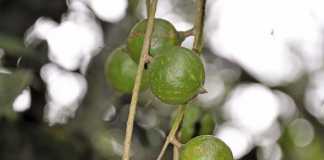Cash crops like maize, sorghum and cotton deplete the soil of its nutrients. For example, a 3,5t/ha maize crop removes 275kg/ha fertiliser from the soil. To make up for these losses, farmers must continually apply mineral fertiliser or manure. Throughout the world, agriculture faces the immense challenge of feeding a growing population in a sustainable, affordable way that doesn’t further threaten biodiversity.
“Doubling food production by mid-century, when many of the world’s soils are depleted and the planet is faced with a changing climate, can’t be achieved with business-as-usual conventional agriculture,” says World Agroforestry Centre (WAC) director general Dr Dennis Garrity. The 1987 World Food Prize Laureate, Dr MS Swaminathan is working with the WAC to develop a system that can increase crop yields on depleted soil in the face of climate change, and bring with it a host of other benefits.
“Combine agroforestry and conservation farming, and you have ‘evergreen agriculture’, a ‘fresh out of the box solution’ to dramatically improve yields while conserving the land,” says Dr Swaminathan, the ‘father of India’s green revolution’. It involves establishing what Malawian smallholder Mariko Majoni calls “a fertiliser factory in the fields” by planting trees that take nitrogen out of the air and “fix” it in their leaves, which are subsequently incorporated into the soil.
Success for African smallholders
When Mariko retired from the prison service in the mid-1990s to begin farming, he used some of his pension to buy mineral fertiliser. Before long, though, the money was gone and he had to do without fertiliser. “In the early years, I got 30 to 40 bags of maize each harvest,” he recalls. “When I stopped using fertiliser, I only got six to nine bags.” From WAC scientists at the nearby Makoka Research Station, Mariko learnt about the benefits of “fertiliser trees”.
He returned home with some Gliricidia seeds and planted them between the rows of maize. At first, his yields remained stubbornly low, but after a couple of years they improved. By 2006 he was getting more than 70 bags from the same plot of land. “My soil is now very rich and much better at retaining water than it used to be,” he says.
Putting the green in evergreen
Conservation farming is already practiced on some 100 million hectares worldwide, while agroforestry systems range from home gardens to subsistence livestock and pastoral systems, staple crops and on-farm timber production. “Agroforestry is recognised worldwide as an important climate change adaptation and mitigation practice by the United Nations Framework Convention on Climate Change and other organisations,” says Frank Place, impact assessment adviser at the WAC.
By providing alternative products, tree cultivation takes pressure off extractive harvesting from natural forests, to limit deforestation, reduce greenhouse gas emissions and fix carbon in farmland. “We suspect that by applying the best of both systems – conservation farming and agroforestry – and carefully testing the new options in a range of environments, it may be possible to double or even triple smallholder maize yields in many areas, without an overall increase in labour or the need for nitrogen fertiliser,” explains Dr Garrity. And it’s not just smallholders who can benefit. This is a system commercial farmers might want to consider, especially since it involves practices many are already employing.
Evergreen principles
According to the WAC report there are three main principles involved in creating an Evergreen Agriculture in Africa:
- As little disturbance to the soil as possible.
- Keep the soil surface covered with organic matter, in the form of crops, crop residue and trees that are compatible with the crops.
- Rotate and diversify crops, with farmers making use of legumes as well as cover crops and trees as additional sources of soil fertility replenishment during the off-season.
By and large, these are standard conservation agriculture practices. Adding trees to the mix, however, increases their efficacy. Or, as Dr Garrity says in The Journal of Food Security, evergreen agriculture “broadens the principle of crop rotation to encompass the role of fertiliser trees and/or other cash crop trees to enhance soil fertility more effectively and provide biological and income diversity in the farm system.
“The types of intercropped trees may include species that provide products or benefits other than soil fertility replenishment alone, such as fodder, fruits, timber and fuelwood. In such cases the trees are expected to provide a greater overall value per square metre than the annual crop, within the area they occupy within the field.”
Research has found the tree components of agroforestry systems stabilise the soil against landslides and increase infiltration. This reduces surface flow during the rainy season and increases groundwater release during the dry season.The inclusion of trees also dramatically increases the potential to store carbon. One tropical tree can sequester at least 22,6kg of carbon from the atmosphere each year. Conservation agriculture with trees can therefore play a role in reducing global warming.
Faidherbia: the tree to plant
Scientists at the WAC, based in Nairobi, Kenya, have been evaluating various species of fertiliser trees for many years, including Sesbania, Gliricidia and Tephrosia. Faidherbia albida, an African acacia, shows the most promise for evergreen agriculture in Africa. It’s compatible with food crops, because it doesn’t compete for light, nutrients or water during the growing season. Only its bare branches spread overhead while the food crops grow to maturity.
Dr Garrity says reports record increases in maize yields ranging from 6% to more than 200%, when grown with Faidherbia, depending on the age and density of the trees, agronomic practices and weather. Faidherbia’s effects tend to be most remarkable when soil fertility is low. The 500 000 farmers in Malawi, Tanzania, and Zambia who cultivate their crops in Faidherbia agroforests say their maize yields have doubled or tripled.
Zambia’s Conservation Farming Unit, for example, has observed that unfertilised maize yields in the vicinity of Faidherbia trees averaged 4,1t/ha, compared to 1,3t/ha nearby, but beyond the tree canopy. Livestock producers also value Faidherbia for its high-quality leaf and pod forage during the most severe droughts.
An alliance emerges
An alliance is emerging between governments, research institutions and international and local development partners committed to expanding evergreen agriculture to farming across Africa. Interest is also developing in southern Asia and Australia.
“Widespread support will be essential to spreading this technology to more than 50 million farmers who desperately need home-grown solutions to their food production problems, while adapting to the unpredictable impacts of climate change,” says the WAC. Adds Frank Place, “It’s vital to develop smarter and harmonised forestry and agriculture policies that don’t inadvertently affect tree management on farms, to recognise the environmental services generated by agroforestry and reward farmers who nurture these trees.”
According to Dr Garrity, the WAC is already working with 18 African countries to develop national plans for evergreen agriculture. “We need to reinvent agriculture in a sustainable and affordable way so that it can adapt to climate change and reduce the emissions of greenhouse gases,” he says.
The WAC is the first to admit that the evergreen agriculture system is still very much under development. It will need to be tested thoroughly in a range of environments and farm conditions, and it’s expected that the results won’t be equally favourable everywhere. All the same, says Dr Garrity, “evergreen agriculture gives us a glimpse of a future of more environmentally-sound farming where a lot of our annual food crop production occurs under a canopy of trees.”
For more information – and a copy of the report Creating an Evergreen Agriculture in Africa – visit the World Agroforestry Centre’s website at www.worldagroforestry.org.













